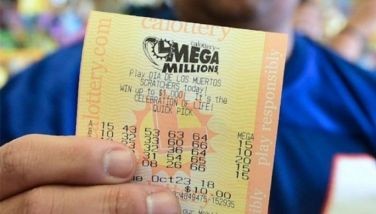BFAR relaxes rules on importation of Pacific white shrimp
August 22, 2004 | 12:00am
The Bureau of Fisheries and Aquatic Resources (BFAR) is relaxing its rules on the importation and commercial propagation of the exotic Pacific white shrimp (litopeneaus vannamei) in the Philippines.
BFAR, after several consultations with local prawn and shrimp producers in Luzon and Visayas, said it will open the immediate and official entry of vannamei into the Philippines "under a managed and closely monitored program by the Department of Agriculture (DA) and BFAR." It said this is allowed under existing Fisheries Administrative Order (FAO 207).
The decision was made with the concurrence of Agriculture Secretary Arthur Yap and House of Representatives Speaker Jose de Venecia who met with industry leaders earlier this month.
BFAR said it is taking a cautious approach on the entry of vannamei into the country. Under the plan, BFAR will be importing disease-free and disease-resistant mother stock of vannamei from recognized breeders in the United States and get them to spawn and produce fry at the agency’s National Integrated Fisheries Technology and Development Center in Bonuan, Pangasinan. The fry will be stocked in the center’s grow-out ponds and grown to marketable sizes where close monitoring of the stock will be conducted to check if diseases occur.
BFAR said that if the first generation of fry will be disease-free up to harvest, it will be considered safe for culture outside and this will be made available to cooperator ponds for trial culture. It is expected that eventually, private hatcheries will be accredited to import their own mother stock for the commercial production of vannamei.
The local availability of vannamei fry will make it unnecessary to smuggle the fry into the country since it is no longer banned.
BFAR Director Malcolm Sarmiento assured the agency will still continue its surveillance to prevent the covert entry of uncertified vannamei fry into the country’s ports of entry.
Groups advocating for the entry of vannamei into the country hope this will perk up the flagging prawn industry, especially prawn exports producers that are being hammered by more cost-efficient producers in the region such as Thailand and Taiwan. Several years ago, these two countries also started to produce the vannamei variety for exports to the US and Japan, two of the biggest export markets.
The new policy according to BFAR, will leave it to the producers to decide which variety to grow. This should settle earlier disagreements between Luzon prawn producers who pushed for the entry and commercial production of vannamei, and the Negros Occidental prawn producers and other growers in the Visayas region who pioneered in exporting black tiger prawn prawns in the 1980s.
Currently, vannamei is being produced primarily for the local market and is known in the wet markets as "suate." The volume being produced is still too small to merit the interest of processors and exporters. It is however, gaining acceptance from local fastfood chains and Chinese restaurants.
Those opposing the commercial propagation of vannamei said there are just too many risks involved with the unfamiliar species.
"The main problem is ensuring domesticated, disease-free and disease- resistant supply of vannamei, which shrimp specialists refer to as Specific Pathogen Free (SPF) and Specific Pathogen Resistant (SPR) shrimp qualities. This would require huge investments in the establishment of a secure hatchery, and setting up monitoring and control systems to prevent contact with infected sources," said Jaime Escober, spokesperson of the Tambuyog Development Center, a non-government organization in the fisheries sector.
He said the risks of contaminating local prawn hatcheries are great, said TDC. These diseases include the Taura syndrome virus and White Spot Syndrome Virus, two diseases that ravaged shrimp farms in the country in 1996 and 1997 and since then halved local shrimp production from its peak of 90,000 metric tons in 1994.
Luzon producers insisted the positive factors outweigh the disadvantages.
Currently, there are 700 hectares of intensive and extensive white shrimp farms in Luzon and producers said that they are making more money because the variety is hardy, it has a high survival rate, low feed conversation ratio, rapid growth during the first 60 days and capability to grow even if part of feed is substituted with lower cost tilapia pellets.
Vannamei grows faster and culture period, at 90-100 days, is less than the 120-185 days it takes for Penaeus monodon or black tiger prawn to be ready for harvesting. Also, the average yield for vannamei is 9-15 metric tons per hectare of intensive farm, compared to 5-10 metric tons per hectare of intensive farm for black tiger.
Allowing the commercial production of vannamei is seen by Luzon prawn growers as a way to revive the local industry, in the same fashion as China and Thailand did with their respective shrimp sectors. Vietnam is also starting to encourage white shrimp fry farming.
BFAR, after several consultations with local prawn and shrimp producers in Luzon and Visayas, said it will open the immediate and official entry of vannamei into the Philippines "under a managed and closely monitored program by the Department of Agriculture (DA) and BFAR." It said this is allowed under existing Fisheries Administrative Order (FAO 207).
The decision was made with the concurrence of Agriculture Secretary Arthur Yap and House of Representatives Speaker Jose de Venecia who met with industry leaders earlier this month.
BFAR said it is taking a cautious approach on the entry of vannamei into the country. Under the plan, BFAR will be importing disease-free and disease-resistant mother stock of vannamei from recognized breeders in the United States and get them to spawn and produce fry at the agency’s National Integrated Fisheries Technology and Development Center in Bonuan, Pangasinan. The fry will be stocked in the center’s grow-out ponds and grown to marketable sizes where close monitoring of the stock will be conducted to check if diseases occur.
BFAR said that if the first generation of fry will be disease-free up to harvest, it will be considered safe for culture outside and this will be made available to cooperator ponds for trial culture. It is expected that eventually, private hatcheries will be accredited to import their own mother stock for the commercial production of vannamei.
The local availability of vannamei fry will make it unnecessary to smuggle the fry into the country since it is no longer banned.
BFAR Director Malcolm Sarmiento assured the agency will still continue its surveillance to prevent the covert entry of uncertified vannamei fry into the country’s ports of entry.
Groups advocating for the entry of vannamei into the country hope this will perk up the flagging prawn industry, especially prawn exports producers that are being hammered by more cost-efficient producers in the region such as Thailand and Taiwan. Several years ago, these two countries also started to produce the vannamei variety for exports to the US and Japan, two of the biggest export markets.
The new policy according to BFAR, will leave it to the producers to decide which variety to grow. This should settle earlier disagreements between Luzon prawn producers who pushed for the entry and commercial production of vannamei, and the Negros Occidental prawn producers and other growers in the Visayas region who pioneered in exporting black tiger prawn prawns in the 1980s.
Currently, vannamei is being produced primarily for the local market and is known in the wet markets as "suate." The volume being produced is still too small to merit the interest of processors and exporters. It is however, gaining acceptance from local fastfood chains and Chinese restaurants.
Those opposing the commercial propagation of vannamei said there are just too many risks involved with the unfamiliar species.
"The main problem is ensuring domesticated, disease-free and disease- resistant supply of vannamei, which shrimp specialists refer to as Specific Pathogen Free (SPF) and Specific Pathogen Resistant (SPR) shrimp qualities. This would require huge investments in the establishment of a secure hatchery, and setting up monitoring and control systems to prevent contact with infected sources," said Jaime Escober, spokesperson of the Tambuyog Development Center, a non-government organization in the fisheries sector.
He said the risks of contaminating local prawn hatcheries are great, said TDC. These diseases include the Taura syndrome virus and White Spot Syndrome Virus, two diseases that ravaged shrimp farms in the country in 1996 and 1997 and since then halved local shrimp production from its peak of 90,000 metric tons in 1994.
Luzon producers insisted the positive factors outweigh the disadvantages.
Currently, there are 700 hectares of intensive and extensive white shrimp farms in Luzon and producers said that they are making more money because the variety is hardy, it has a high survival rate, low feed conversation ratio, rapid growth during the first 60 days and capability to grow even if part of feed is substituted with lower cost tilapia pellets.
Vannamei grows faster and culture period, at 90-100 days, is less than the 120-185 days it takes for Penaeus monodon or black tiger prawn to be ready for harvesting. Also, the average yield for vannamei is 9-15 metric tons per hectare of intensive farm, compared to 5-10 metric tons per hectare of intensive farm for black tiger.
Allowing the commercial production of vannamei is seen by Luzon prawn growers as a way to revive the local industry, in the same fashion as China and Thailand did with their respective shrimp sectors. Vietnam is also starting to encourage white shrimp fry farming.
BrandSpace Articles
<
>
- Latest
Latest
Latest
March 4, 2024 - 3:32pm
By Ian Laqui | March 4, 2024 - 3:32pm
March 4, 2024 - 2:12pm
By Kristine Daguno-Bersamina | March 4, 2024 - 2:12pm
February 17, 2024 - 2:31pm
February 17, 2024 - 2:31pm
February 13, 2024 - 7:24pm
By Gaea Katreena Cabico | February 13, 2024 - 7:24pm
February 13, 2024 - 7:17pm
By Ian Laqui | February 13, 2024 - 7:17pm
Recommended

























